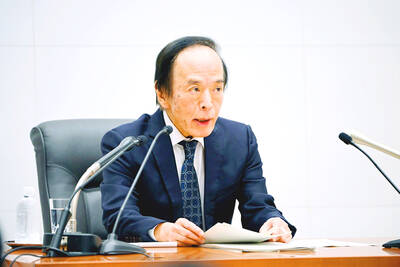Taiwan’s industrial output contracted 3.28 percent year-on-year last month, the biggest decline in 15 months, because of declining output of machinery equipment, cars and car parts, computers, electronics and optical products, the Ministry of Economic Affairs said yesterday.
Last month’s output was 23.79 percent higher than February, when the Lunar New Year holiday shortened the number of working days, the ministry said.
Manufacturing production — which accounts for more than 90 percent of the nation’s total factory output and includes the electronics, chemical, machinery, foodstuffs and textile sectors — declined 3.24 percent year-on-year last month.
In the first quarter, industrial output rose 0.78 percent year-on-year because of an increase in construction activity, but declined 6.1 percent from a quarter ago, the ministry said.
The latest report showed machinery equipment output last month dropped 13.63 percent year-on-year, which was mainly due to increased competition from Japanese companies amid the depreciation of the yen and decreasing global demand.
The output of automobiles and key components for automobiles also declined 9.2 percent from a year earlier as customers waited for prices to decline amid the depreciation of the yen, Yang Kuei-hsien (楊貴顯), deputy director-general of the ministry’s statistics department, told a press conference.
The 7.04 percent year-on-year decline in computers, electronics and optical products last month was mainly due to the reduced output of new smartphones as a result of a shortage of key components, Yang said.
Citing the ministry’s sentiment survey among manufacturers, Yang said the ministry expects industrial output this month to be flat from last month, but to rise slightly compared with a year ago.
As for this quarter, he said industrial output would likely see a quarter-on-quarter increase, but the increase would be mild.
The industrial output data came after the ministry said on Monday that export orders — an indication of shipments for the next one to three months — last month contracted 6.6 percent to US$35.84 billion from US$38.37 billion a year ago, the second consecutive annual decline this year.
Market sentiment has been highly volatile recently, Yang said, adding that the outlook for the second half of this year remained murky.
“For example, the market conditions in the petrochemical and steel industries shifted from positive to gloomy after the Lunar New Year holiday,” Yang said.
On the domestic front, revenue of the wholesale, retail and restaurant sectors was NT$1.18 trillion (US$39.57 billion) last month, down 0.7 percent from a year ago, but 13.7 percent higher than the previous month, the ministry said in a separate report.
Cumulative revenue last quarter amounted to NT$3.44 trillion, up 0.4 percent year-on-year, the data showed.

Taiwan’s long-term economic competitiveness will hinge not only on national champions like Taiwan Semiconductor Manufacturing Co. (TSMC, 台積電) but also on the widespread adoption of artificial intelligence (AI) and other emerging technologies, a US-based scholar has said. At a lecture in Taipei on Tuesday, Jeffrey Ding, assistant professor of political science at the George Washington University and author of "Technology and the Rise of Great Powers," argued that historical experience shows that general-purpose technologies (GPTs) — such as electricity, computers and now AI — shape long-term economic advantages through their diffusion across the broader economy. "What really matters is not who pioneers

In a high-security Shenzhen laboratory, Chinese scientists have built what Washington has spent years trying to prevent: a prototype of a machine capable of producing the cutting-edge semiconductor chips that power artificial intelligence (AI), smartphones and weapons central to Western military dominance, Reuters has learned. Completed early this year and undergoing testing, the prototype fills nearly an entire factory floor. It was built by a team of former engineers from Dutch semiconductor giant ASML who reverse-engineered the company’s extreme ultraviolet lithography (EUV) machines, according to two people with knowledge of the project. EUV machines sit at the heart of a technological Cold

TAIWAN VALUE CHAIN: Foxtron is to fully own Luxgen following the transaction and it plans to launch a new electric model, the Foxtron Bria, in Taiwan next year Yulon Motor Co (裕隆汽車) yesterday said that its board of directors approved the disposal of its electric vehicle (EV) unit, Luxgen Motor Co (納智捷汽車), to Foxtron Vehicle Technologies Co (鴻華先進) for NT$787.6 million (US$24.98 million). Foxtron, a half-half joint venture between Yulon affiliate Hua-Chuang Automobile Information Technical Center Co (華創車電) and Hon Hai Precision Industry Co (鴻海精密), expects to wrap up the deal in the first quarter of next year. Foxtron would fully own Luxgen following the transaction, including five car distributing companies, outlets and all employees. The deal is subject to the approval of the Fair Trade Commission, Foxtron said. “Foxtron will be

INFLATION CONSIDERATION: The BOJ governor said that it would ‘keep making appropriate decisions’ and would adjust depending on the economy and prices The Bank of Japan (BOJ) yesterday raised its benchmark interest rate to the highest in 30 years and said more increases are in the pipeline if conditions allow, in a sign of growing conviction that it can attain the stable inflation target it has pursued for more than a decade. Bank of Japan Governor Kazuo Ueda’s policy board increased the rate by 0.2 percentage points to 0.75 percent, in a unanimous decision, the bank said in a statement. The central bank cited the rising likelihood of its economic outlook being realized. The rate change was expected by all 50 economists surveyed by Bloomberg. The